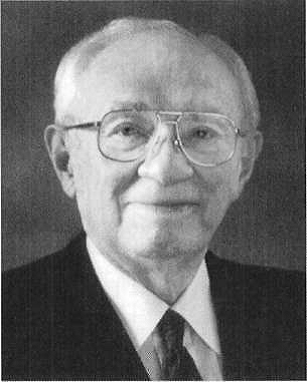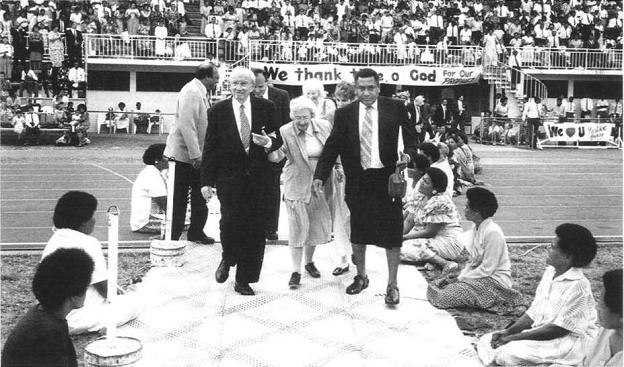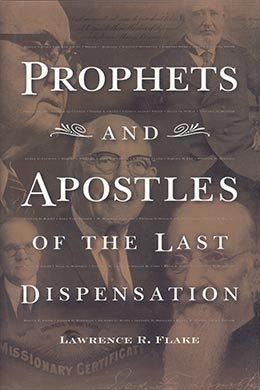Gordon Bitner Hinckley
Lawrence R. Flake, Prophets and Apostles of the Last Dispensation (Provo, UT: Religious Studies Center, Brigham Young University, 2001), 141–48.

Born: 23 June 1910, Salt Lake City, Utah
Assistant to the Quorum of the Twelve: 6 April 1958
Quorum of the Twelve Apostles: 5 October 1961 (age 51)
Additional counselor to President Spencer W. Kimball: 23 July 1981
Second counselor to President Spencer W. Kimball: 2 December 1982
First counselor to President Ezra Taft Benson: 10 November 1985
First counselor to President Howard W. Hunter: 5 June 1994
President of the Church: 12 March 1995 (age 84)
The president of the European Mission, Joseph F. Merrill, arranged to have one of his returning missionaries make a brief report to President Heber J. Grant concerning the affairs of the mission. As the missionary, Gordon B. Hinckley, entered the office of the First Presidency, he was told that he would have fifteen minutes to make the report. The interview lasted an hour and fifteen minutes, and the Brethren were so impressed with the talents and abilities of the young elder that a few days later, he was offered the position of executive secretary of the Church’s Radio, Publicity, and Mission Literature Committee. With this opportunity, Gordon Bitner Hinckley began a lifetime of service to the Church that would eventually lead to his becoming its fifteenth president.
President Hinckley was born on 23 June 1910 to Bryant S. and Ada Bitner Hinckley. His father was a well-known Church historian, teacher, and writer. His mother was also well educated and taught at LDS College in Salt Lake City. Gordon was ill as a child, and when a doctor recommended “more fresh air and sunlight,” the Hinckleys bought a farm in the East Mill Creek area. [1] During the winter, they lived in their home in Salt Lake City, but summers were spent on the farm. It was here that young Gordon gained a love of the outdoors and learned to work—not only to milk cows and pick fruit, but to repair the cars, the household electricity, and the plumbing as well. The family built a farmhouse there, which became Gordon and Marjorie Pay Hinckley’s first home when they were married in April of 1937. They soon outgrew the small farmhouse, though, so doing much of the work himself, President Hinckley built a home for his family on the East Mill Creek property. Marjorie and Gordon had known each other since childhood, as she had grown up across the street from the Hinckleys in Salt Lake City. President and Sister Hinckley became the parents of five children—three daughters and two sons. [2]
President Hinckley’s childhood home fostered many of the great talents he would use later to build up the Church throughout the earth. Both of his parents were avid book lovers, and Gordon caught the vision to “seek learning, even by study and also by faith.” He recalled, “I look back at myself as a shy and bashful boy—freckle-faced and awkward. But, I was blessed with a great father, a man of many gifts, literary gifts, business acumen and a tremendous capacity to accomplish.” [3] As a twelve-year-old boy, he attended his first stake priesthood meeting with his father. As the congregation of men sang the opening hymn “Praise to the Man,” a feeling President Hinckley never forgot came over him: “There welled up in me an overwhelming conviction!” He knew as a young deacon that Joseph Smith was a prophet of God. Later, whenever his faith was challenged, “the memory of that moment sustained him.” President Boyd K. Packer observed, “Even today, more than six decades later, he cannot tell of that experience without slipping a finger under his glasses to prevent a tear from rolling down his cheek.” [4]
Early in his life, President Hinckley displayed an exceptional gift for public speaking. During his college years, the bishop of his ward asked him to substitute for apostle Reed Smoot, a U.S. senator, who was unable to come to speak to the overflow audience awaiting him. Young Gordon Hinckley got up to address the disappointed audience. A friend who heard him recalled, “When Gordy Hinckley finished speaking, people had forgotten all about Senator Smoot’s absence. The boy really stirred them.” [5] After obtaining his undergraduate degree from the University of Utah in 1935, he had dreams of going to Columbia University and pursuing a degree in journalism, but his bishop changed those plans. He issued a call for President Hinckley to serve a mission instead. He labored in the European Mission from 1933 to 1935, becoming an assistant to his mission president, Elder Joseph F. Merrill, who was a member of the Twelve. [6]
Early in his mission, Elder Hinckley wrote a letter home to his father indicating that he had become despondent and discouraged. He wrote, “I don’t see any point in my staying here.” He felt the money, hard to come by in the Depression years, was being wasted on him. His father wrote a simple reply that changed his life. “Dear Gordon. I have your letter. I have only one suggestion. Forget yourself and go to work.” President Hinckley recalled, “I pondered his response and then the next morning in our scripture class we read that great statement of the Lord: ‘For whosoever will save his life shall lose it; but whosoever shall lose his life for my sake and the gospel’s, the same shall save it’ (Mark 8:35). That simple statement, that promise, touched me. I got on my knees and made a covenant with the Lord that I would try to forget myself and go to work. I count that as the day of decision in my life. Everything good that has happened to me since then I can trace back to the decision I made at that time.” [7]
His talent for writing became evident in his role as executive secretary of the Church Radio, Publicity, and Literature Committee, the position he accepted following his mission. He distinguished himself by writing a Church History radio series entitled “The Fullness of Times,” which was produced in Hollywood. These dramatizations “were really the forerunner of all the things we’ve done since in the way of radio and television productions,” said President Hinckley. [8] And “things” certainly were done—President Hinckley moved from that first Church assignment to the responsibility of managing the Missionary Department, where he had the responsibility for preparing and printing all the missionary literature, including translating it into many languages. A well-loved book, Meet the Mormons, which sold over five million copies, was one of the many projects he brought to fruition during those years, along with hundreds of pamphlets, tracts, and helps for missionaries in teaching the gospel. From 1937 to 1946 he served on the board of the Deseret Sunday School Union.
The only break in President Hinckley’s Church service was during World War II, when he took employment with the Denver and Rio Grand Western Railroad Company. A promotion to assistant manager of mail, baggage, and express for the entire system took him and his family to Denver for about a year. When the war was over he returned to the Church offices, only to receive a lucrative offer from the railroad, enticing him to return to their employ. But he turned them down, realizing the direction his life must take. “This is the Lord’s work,” he said at the time. “I felt I would make my best contribution in life by continuing to do my humble part to further the cause.” [9]
Besides the tremendous amount of work managing the missionary program of the Church, which consisted of handling the problems arising from sick missionaries, balancing delicate military relations, distributing mission literature, putting together radio broadcasts, devising mission reports, working with mission presidents, and so forth, President Hinckley also served from 1946 to 1956 as a counselor in a stake presidency and then for two years as president of the East Mill Creek Stake, which was located in one of the fastest-growing areas in the Church. While he served in the stake presidency, fifteen new wards were created, as well as three new stakes. He oversaw the fund-raising and construction of a new stake center in the fields of East Mill Creek where he had roamed as a boy. [10] In addition, President Hinckley has served on the boards of many business organizations (most of which were connected with the Church), demonstrating his talent in the business area as well. Among these are The Church News Publishing Company and Bonneville International Corporation.
In 1958 President Hinckley was called to be an Assistant to the Twelve, and then in October 1961 he was called to be a member of the Twelve. In July 1981 he was chosen as an additional counselor in the First Presidency under Spencer W. Kimball. In 1982 he became second counselor to President Kimball, and in November 1985 he became first counselor to Ezra Taft Benson and subsequently to Howard W. Hunter. He was thus a counselor to three presidents of the Church. Because of the illnesses of President Kimball, President Benson, and also Elder Romney (the other counselor to President Kimball), President Hinckley carried much of the burden of the First Presidency for several years. On 12 March 1995, following the death of President Hunter, Gordon B. Hinckley became president of the Church at the age of eighty-four.
Among President Hinckley’s contributions in his many years as a general authority are the unified missionary discussions, the films used in the temples today, and the tremendous growth of the missionary work in Asia and the Pacific, South America, and Europe. At the time of his eightieth birthday, he remarked that his visits to Asia alone added up to nearly three and a half years, and that recently, he had taken his forty-fifth trip to those regions in the eleven years he had supervised the work there. [11] In 1961 he made the arrangements for the first missionaries to enter the Philippines and witnessed phenomenal growth of the Church in that country stemming from that inspired beginning. The Church population grew to 320,000 members in just thirty years. [12]
 President Gordon B. Hinckley with his wife, Marjorie Hinckley, at a conference in Fiji
President Gordon B. Hinckley with his wife, Marjorie Hinckley, at a conference in Fiji
President Hinckley has also been a dominant figure in multiplying the number of temples scattered throughout the world. At the time of his sustaining as the prophet of the Church, he had dedicated or rededicated twenty-six of the Church’s forty-seven working temples. [13] In the October 1997 general conference, President Hinckley made public the Church’s plan to construct a number of smaller temples that would be located next to stake centers, an idea he had thought about for many years. [14] Six months later, he announced that thirty of these would be built by the end of the century, bringing the total number of temples to ninety-eight. At a news conference held at the time he became president of the Church, he commented, “The most serious challenge we face and the most wonderful challenge is the challenge that comes of growth. Accommodating the tremendous growth of the Church presents many problems.” [15]
President Hinckley has been very instrumental in creating this “problem” of growth for the Church. Over his sixty-three years as a Church employee and general authority, the strides made in missionary work and in the growth of the Church have been astounding. From some 746,000 members and only two stakes outside the United States in 1935 when President Hinckley first began working for the Church, membership has grown to eleven million members and over 2,500 stakes, with more Church members outside the United States than within.
In spite of the major role he has played in this growth, however, President Hinckley remains unassuming, giving credit to the Lord for the success the Church has had. “One cannot come to this sacred office without almost overwhelming feelings of inadequacy,” he said. “Strengthened resolution to go forward comes from the knowledge that this is the work of God, that He is watching over it, that He will direct us in our efforts if we will be true and faithful, and that our accountability is to Him. . . . We are dedicated, as have been those before us, to teaching the gospel of peace, to . . . bearing witness to the living reality of our Lord Jesus Christ, and to the practice of His teachings in our daily lives.” [16] With tremendous physical and spiritual energy, he has dedicated himself to travel throughout the Church, meeting and mingling with as many of the Saints as he can. “We want to get out with the people. It is important for us to meet with the people and feel of their pulse, out across the world.” [17]
Notes
[1] Wendell J. Ashton, “Gordon B. Hinckley of the Quorum of the Twelve,” Improvement Era, December 1961, 978–80.
[2] Ashton, “Gordon B. Hinckley,” 982.
[3] J. M. Heslop, “Hard Work and Responsibility Bring Success,” Church News, 8 February 1975, 4.
[4] Boyd K. Packer, “President Gordon B. Hinckley: First Counselor,” Ensign, February 1986, 5.
[5] Ashton, “Gordon B. Hinckley,” 982.
[6] Heslop, “Hard Work and Responsibility,” 4.
[7] Jeffrey R. Holland, “President Gordon B. Hinckley: Stalwart and Brave He Stands,” Ensign, June 1995, 8.
[8] Dell Van Orden, “It Really Has Been a Great and Good Life,” Church News, 23 June 1990, 6.
[9] Ashton, “Gordon B. Hinckley,” 978.
[10] Ashton, “Gordon B. Hinckley,” 982–83.
[11] Van Orden, “Great and Good Life,” 6.
[12] John L. Hart, “Roots Are Embedded in Responsibility,” Church News, 18 March 1995, 12.
[13] Hart, “Roots Are Embedded,” 12.
[14] Sheri L. Dew, Go Forward With Faith: The Biography of Gordon B. Hinckley (Salt Lake City: Deseret Book, 1996), 325, 419.
[15] Dell Van Orden, “Pres. Hinckley Ordained Prophet,” Church News, 18 March 1995, 10.
[16] Van Orden, “Pres. Hinckley Ordained Prophet,” 10.
[17] Van Orden, “Pres. Hinckley Ordained Prophet,” 10.
